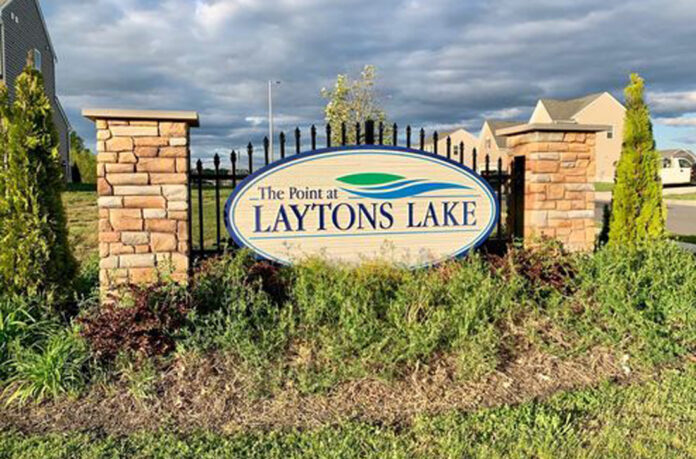
Still, Carneys Point suffers as a food dessert – those seeking fresh vegetables, decently-price fruits, and healthy meals must head south across the bridge into Delaware (where a hefty toll awaits each crossing) or north several miles to Greenwich Township or beyond. It’s little wonder why the marketing of The Point appeared to have focused on African Americans. It’s also little wonder why homeowner’s associations tack on quarterly fees that leave residents often wondering, “just where does the money go?”
Stacy M. Brown, NNPA Newswire Senior National Correspondent
Homeownership proved an excellent idea for many of the 70 or so families who bought into this tempting advertisement:
“Imagine owning your own brand new, single-family home on a spacious half-acre homesite with a private backyard! Being more affordable than a townhome, you will quickly see just why so many have chosen to call The Point at Laytons Lake home.”
Tucked away just a couple of miles from the Delaware Memorial Bridge in Carneys Point, N.J., is the enclave called “The Point at Laytons Lake.”
The area’s one claim to fame? Actor Bruce Willis grew up blocks away – a gaggle of his photos adorns the walls of a local eatery called Roman Pantry.
Nearby warehouses, doctor’s offices, and a county hospital offer most of the nearby job opportunities.
Still, Carneys Point suffers as a food dessert – those seeking fresh vegetables, decently-price fruits, and healthy meals must head south across the bridge into Delaware (where a hefty toll awaits each crossing) or north several miles to Greenwich Township or beyond.
It’s little wonder why the marketing of The Point appeared to have focused on African Americans.
It’s also little wonder why homeowner’s associations tack on quarterly fees that leave residents often wondering, “just where does the money go?”
“All fees for the Laytons Lake HOA are currently in escrow, and we plan to work with our CPA to send everyone a statement, so you’ll understand where the fees have been applied to date,” Akilah Linder, a loyal member of the Laytons Lake HOA board, insisted in an email.
The message only served to underscore residents’ concerns at the three-year-old development, where some estimates say at least 90 percent of homeowners are people of color.
“They’ve never told us where our money is going,” said one resident who didn’t want to state his identity.
“They say they have tree planting and maintenance. Well, no one asked for trees, they don’t do any landscaping, and all of us have to take care of our own lawns and snow removal,” the resident continued.
Another resident called the HOA fees “a rip off.”
“Black people,” the frustrated homeowner exclaimed. “We can’t catch a break. They saw us coming, and you know they’ve got other Black people to do their bidding for them to oppress us.”
Laytons Lake residents aren’t alone in their frustration with its HOA – it’s a systemic and mostly racist establishment.

It’s also little wonder why homeowner’s associations tack on quarterly fees that leave residents often wondering, “just where does the money go?”
In an August 2020 post by writer Jennifer Povey titled “The Racist History of Your Homeowner’s Association,” the author lists many HOA horror stories.
The dirty deeds include pet bans, sign size limits, fights over flags, and “in some cases, truly stupid rules.”
The rules include specific color for swing sets and garage doors, requirements for blinds rather than curtains, parking all vehicles in garages regardless of size.
In July 2019, a woman in Florida read through the covenants for the home she considered buying, Povey recalled in her post.
“Perhaps nobody had read them recently because the documents, written in the 1930s, still said that only ‘Caucasians’ could live in the neighborhood,” she wrote.
Povey noted that “HOAs really came into their own in the 1950s and 1960s…and redlining was the rule, not the exception.”
She said covenants would commonly exclude three groups of people — Jews, Blacks, and Asians. In 1948, the U.S. Supreme Court ruled that these covenants violated the Civil Rights Act of 1866.
“Which meant that people need to come up with other ways to keep out the undesirables,” Povey concluded.
“They wanted to make sure that their neighborhood only contained the right (or rather white) kind of people. Outright racist language is illegal, but it’s often still in there. Just because it’s illegal and unenforceable doesn’t mean it doesn’t have a chilling effect when people notice it.”
In an HOA arrangement, Povey argued that homeowners of color might find themselves fined or harassed for petty violations while worse ones by their white neighbors are ignored.
According to homestratophere.com, there are over 351,000 HOAs across America representing about 40 million homeowners, or 53 percent of all homes in the U.S.
The website determined that “while it’s not impossible to avoid an HOA, it’s definitely difficult depending on where you want to buy.”
According to Bankrate.com, the national average HOA fee for a single-family home is between $200 and $300.
However, HOA fees vary widely depending on the property location and the amenities available to property owners, Bankrate.com reported.
The board that runs the HOA decides how much to charge property owners to cover the community’s expenses.
UrbanTurf reported that dues rose 32.4 percent between 2005 and 2015 across the nation.
This resulted in the median monthly dues changing from $250 to $331.
In the same amount of time, the median monthly HOA dues in the D.C. area rose from $259 to $387, a 49.4 percent increase.
While costs have risen, UrbanTurf reported that the number of households in the Washington, D.C. area paying HOA dues has dropped by 1.2 percent over the past decade.
“I live in Columbia Heights and the biggest problem for me, and my husband are our HOA fees,” said Heather Keita.
“What does [our HOA dues] cover? We spoke with our friends who live in Forest Hills, and they pay about half of what we pay,” Keita continued. “I work in retail, so I don’t really have a legal background to go up against our HOA, but I feel it’s past time that someone did something about it.”
At Laytons Lake, residents haven’t realized any benefits of the HOA.
Snow removal and lawn maintenance are paid for by the homeowners and average about $200 per month. HOA fees there are more than $800 per year.
Further, Laytons Lake doesn’t offer amenities like playgrounds, clubhouses, and repairs to properties that many other HOAs provide.
They also don’t have any oversight or a property management company which makes it difficult to justify the high costs of quarterly fees.
“There are some HOAs whereby the fees are lower than what we are currently paying. However, each HOA fee structure differs (globally) because of amenities that they have,” Linder at Laytons Lake determined.
“Although there are some HOAs that pay $20 a month, there are some HOA’s that also charges $300 a month because they have swimming pools, tennis courts, etc… All fees for the Laytons Lake HOA are currently in escrow,” she continued.
“Our goal for the last two years is to decrease what we are currently paying monthly. However, this cannot occur until the developer finishes the punch list with the township, which includes tree planting.”


